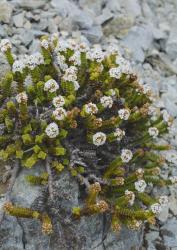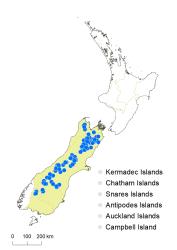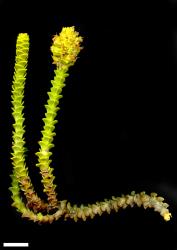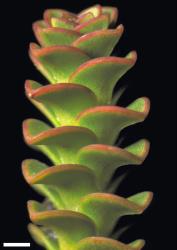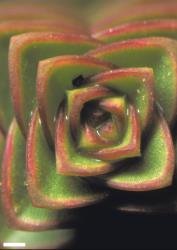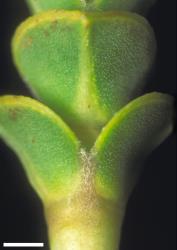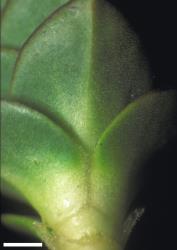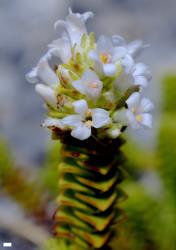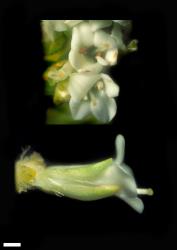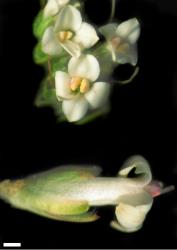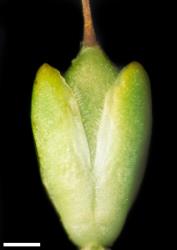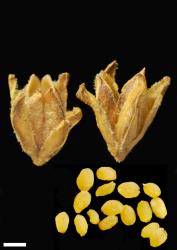- Taxon
- Gallery
- ≡ Hebe epacridea (Hook.f.) Andersen, Trans. New Zealand Inst. 56: 693 (1926)
- ≡ Leonohebe epacridea (Hook.f.) Heads, Bot. Soc. Otago Newsl. 5: 6 (1987)
Spreading low shrub to 0.4 m tall. Stems decumbent to ascending, eglandular-pubescent or rarely glabrous; hairs bifarious or sometimes uniform. Leaf bud distinct, its outer leaves fully grown, diverging. Leaves opposite-decussate, connate in pairs and encircling stem, erect when young, erecto-patent to recurved, separating early; lamina coriaceous and rigid, broadly ovate, elliptic, oblong or orbicular, 2.5–9.0 mm long, 2.5–7.0 mm wide, more or less dull green to dark green above, green beneath; veins not evident but lamina keeled beneath; surfaces glabrous but eglandular-hairy at connate bases beneath; margin ciliate towards base, otherwise glabrous or minutely papillate, entire or rarely minutely crenulate or with a few shallow teeth; apex obtuse or sub-acute; base broad; petiole absent. Inflorescence a terminal compound spike, 5–26 mm long; flowers crowded, 2–8 per lateral spike, female or bisexual on separate plants, ⚥ > ♀; bracts opposite-decussate and connate below, becoming alternate above, ovate or deltoid, = calyx; pedicels absent. Calyx lobes 4, obtuse, sub-acute, or acuminate, 3.0–5.5 mm long, sub-equal, ciliate with long eglandular mixed with long and short glandular hairs. Corolla 6–8 (⚥) or 4–5 (♀) mm diameter; tube white, 3.8–5.5 (⚥) or 2.4–4.0 (♀) mm long, ≥ calyx, glabrous; lobes 4, white or creamy white, sub-erect to spreading or recurved, sub-equal, lanceolate, elliptic, ovate, or orbicular, 2.5–3.5 (⚥) or 2.0–2.5 (♀) mm long, sub-acute or obtuse; nectar guides absent. Stamen filaments white, 0.8–1.2 mm long (shorter in ♀); anthers yellow, pink, or magenta. Style glabrous, rarely hairy at base, 2.5–7.0 mm long. Capsule latiseptate, sub-acute, glabrous or sometimes hairy, 2.7–4.5 mm long, 1.5–2.6 mm at widest point. Seeds ellipsoid, ovoid, or obovoid, flattened, smooth, straw-yellow, 0.8–1.1 mm long.
Plants of V. epacridea and several similar species such as V. haastii, V. macrocalyx, and V. kellowiae are similar in habit, connate leaf bases, and compact terminal simple or compound inflorescences. Plants of V. epacridea can be distinguished from the others by their thick and rigid leaves, which are often concave or recurved and keeled (flat from Mt Cook southwards), not narrowed at the base, by the dead leaves being retained along stems, and by the margins of bracts and calyx lobes being fringed with long cilia. Leaves often have red margins, and these may or may not be heavily thickened (reinforced by a marginal vein).
South Island: Western Nelson, Sounds Nelson, Marlborough, Westland (near the Main Divide), Canterbury, Otago (west), Southland (Eyre and Livingston Mountains).
Alpine rock debris and screes, sometimes descending to lower altitudes in gullies, screes and stream beds. Recorded elevations range from 638 to 2745 m.
Flowers: December–February, occasionally to April; fruits: December–April, sometimes persisting to September.
2n = 42 (see Bayly & Kellow 2006, as Hebe epacridea).
Veronica epacridea is classified in V. subg. Pseudoveronica sect. Hebe and the informal group “Connatae” (Albach & Meudt 2010; Bayly & Kellow 2006). Phylogenetic analyses of nuclear DNA (ITS) strongly supported a sister relationship between V. epacridea (as Hebe epacridea) and V. kellowiae (as Hebe ramosissima). When more species of “Connatae” were included (E.M. Low, unpublished), V. epacridea and V. haastii were sister species, closely related to V. macrocalyx and V. kellowiae, but not to other “Connatae” such as V. murrellii and V. petriei.
This widespread species shows some patterns of regional variation. In Nelson, Marlborough, and Canterbury north of Aoraki / Mt Cook National Park, the marginal vein is heavily thickened and smooth. Further south, especially at Aoraki / Mt Cook National Park and in South Otago, leaves are not strongly concave and recurved, and the marginal vein is barely thickened. In those leaves the marginal vein connects the radiating veins near the margin with arching loops. In some locations the looping marginal vein is weakly thickened, presenting a scalloped appearance (see Bayly & Kellow 2006, Fig. 61).



